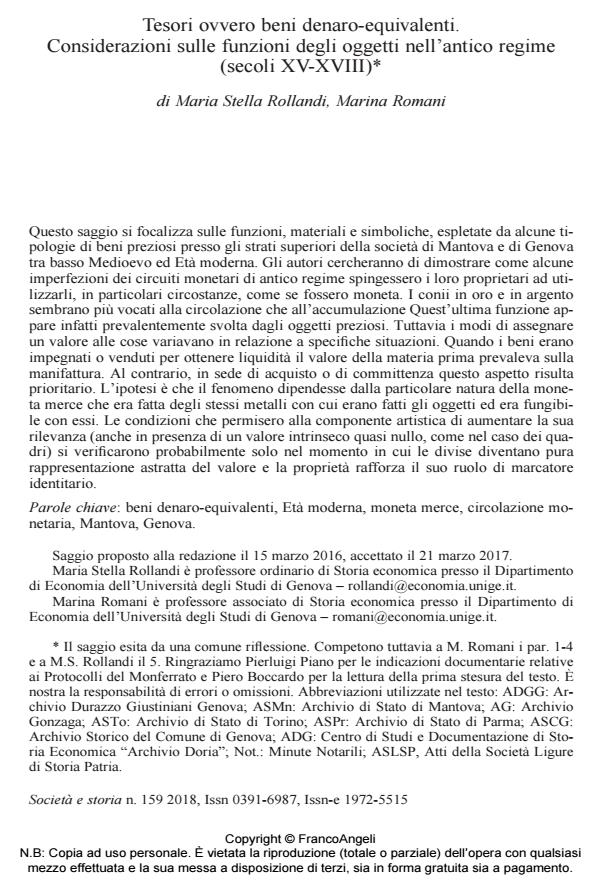Tesori ovvero beni denaro-equivalenti. Considerazioni sulle funzioni degli oggetti nell’antico regime (secoli XV-XVIII)
Titolo Rivista SOCIETÀ E STORIA
Autori/Curatori Maria Stella Rollandi, Marina Romani
Anno di pubblicazione 2018 Fascicolo 2018/159
Lingua Italiano Numero pagine 34 P. 1-34 Dimensione file 119 KB
DOI 10.3280/SS2018-159001
Il DOI è il codice a barre della proprietà intellettuale: per saperne di più
clicca qui
Qui sotto puoi vedere in anteprima la prima pagina di questo articolo.
Se questo articolo ti interessa, lo puoi acquistare (e scaricare in formato pdf) seguendo le facili indicazioni per acquistare il download credit. Acquista Download Credits per scaricare questo Articolo in formato PDF

FrancoAngeli è membro della Publishers International Linking Association, Inc (PILA)associazione indipendente e non profit per facilitare (attraverso i servizi tecnologici implementati da CrossRef.org) l’accesso degli studiosi ai contenuti digitali nelle pubblicazioni professionali e scientifiche
Questo saggio si focalizza sulle funzioni, materiali e simboliche, espletate da alcune tipologie di beni preziosi presso gli strati superiori della società di Mantova e di Genova tra basso Medioevo ed Età moderna. Gli autori cercheranno di dimostrare come alcune imperfezioni dei circuiti monetari di antico regime spingessero i loro proprietari ad utilizzarli, in particolari circostanze, come se fossero moneta. I conii in oro e in argento sembrano più vocati alla circolazione che all’accumulazione Quest’ultima funzione appare infatti prevalentemente svolta dagli oggetti preziosi. Tuttavia i modi di assegnare un valore alle cose variavano in relazione a specifiche situazioni. Quando i beni erano impegnati o venduti per ottenere liquidità il valore della materia prima prevaleva sulla manifattura. Al contrario, in sede di acquisto o di committenza questo aspetto risulta prioritario. L’ipotesi è che il fenomeno dipendesse dalla particolare natura della moneta merce che era fatta degli stessi metalli con cui erano fatti gli oggetti ed era fungibile con essi. Le condizioni che permisero alla componente artistica di aumentare la sua rilevanza (anche in presenza di un valore intrinseco quasi nullo, come nel caso dei quadri) si verificarono probabilmente solo nel momento in cui le divise diventano pura rappresentazione astratta del valore e la proprietà rafforza il suo ruolo di marcatore identitario.
Parole chiave:Beni denaro-equivalenti, Età moderna, moneta merce, circolazione monetaria, Mantova, Genova.
- Quale storia della società? Uno sguardo sull'epoca moderna Paola Bianchi, in SOCIETÀ E STORIA 178/2023 pp.711
DOI: 10.3280/SS2022-178005 - Private Bankers in the Italian 19th Century Luciano Maffi, pp.1 (ISBN:978-3-030-63360-8)
Maria Stella Rollandi, Marina Romani, Tesori ovvero beni denaro-equivalenti. Considerazioni sulle funzioni degli oggetti nell’antico regime (secoli XV-XVIII) in "SOCIETÀ E STORIA " 159/2018, pp 1-34, DOI: 10.3280/SS2018-159001